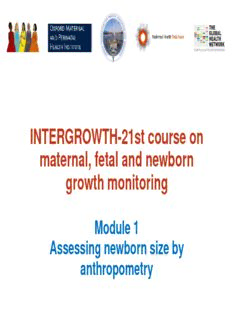
Assessing newborn size by anthropometry PDF
Preview Assessing newborn size by anthropometry
INTERGROWTH-21st course on maternal, fetal and newborn growth monitoring Module 1 Assessing newborn size by anthropometry INTERGROWTH-21st Module 1 Assessing newborn size by anthropometry On successful completion of this module you should be able to: • List the instruments used for neonatal anthropometry. • Accurately measure newborn weight, length and head circumference. • Use the INTERGROWTH-21st standards for newborn size at birth and INTERGROWTH-21st Newborn Size Application Tool. INTERGROWTH-21st Module 1 Assessing newborn Introduction size by anthropometry • The lack of growth standards for pregnancy dating, fetal growth, maternal weight gain, newborn size and preterm postnatal growth greatly limits our understanding of early growth and development during pregnancy and comparisons across international populations (Bhutta, 2013; Villar et al., 2015). • The aetiology and epidemiology of fetal growth restriction and preterm birth syndromes are also significantly impaired by the absence of an international standard for intrauterine growth with which to compare deviations and identify phenotypes (Bhutta, 2013; Villar et al., 2015). • Since optimal fetal and neonatal growth and their implications for long-term outcomes are of utmost importance, it is a priority to define optimal intrauterine growth in populations where nutrition and health needs are met (Bhutta, 2013; Villar et al., 2015). BhuttaZ, for the International Fetaland Newborn Growth Consortium for the 21stCentury (INTERGROWTH-21st). Introduction. BJOG 2013 Sep;120:1-2. VillarJ, PapageorghiouAT, Pang R, Monitoring human growth and development: a continuum from the womb to the classroom. Am J ObstetGynecol2015 Oct 1;213(4):494-9. INTERGROWTH-21st Module 1 Assessing newborn Introduction size by anthropometry • The International Fetal and Newborn Growth Consortium for the 21st Century (INTERGROWTH-21st) Project aimed to prospectively define fetal and newborn growth, and postnatal growth among preterm infants (Bhutta, 2013). • The INTERGROWTH-21st Project was a multicentre, multi-ethnic, population-based project in eight urban study sites (Villar et al., 2015). • Populations were first selected by geographical location (altitude, level of antenatal care, absence or low levels of major known non-microbiological contamination) and then by individual characteristics (e.g. maternal demographics and medical history) (Villar et al., 2014). BhuttaZ, for the International Fetaland Newborn Growth Consortium for the 21stCentury (INTERGROWTH-21st). Introduction. BJOG 2013 Sep;120:1-2. VillarJ, Ismail LC, VictoraCG, et al. International standards for newbornweight, length, and head circumference by gestational age and sex: the NewbornCross-Sectional Study of the INTERGROWTH-21st Project. The Lancet. 2014;384(9946):857-68. VillarJ, PapageorghiouAT, Pang R, Monitoring human growth and development: a continuum from the womb to the classroom. Am J ObstetGynecol2015 Oct 1;213(4):494-9. INTERGROWTH-21st Module 1 Assessing newborn Introduction size by anthropometry • The INTERGROWTH-21st Project produced international standards (Villar et al., 2015): • For gestational age estimation • First-trimester fetal size • Fetal growth • Newborn size for gestational age • Postnatal growth of preterm infants • Maternal gestational weight gain • The Anthropometry Handbook used in this project describes how to perform accurate, precise and standardised anthropometric measurements for the assessment of maternal and newborn size. VillarJ, PapageorghiouAT, Pang R, Monitoring human growth and development: a continuum from the womb to the classroom. Am J ObstetGynecol2015 Oct 1;213(4):494-9. IINNTTEERRGGRROOWWTTHH--2211sstt MMoodduullee 11 AAsssseessssiinngg nneewwbboorrnn ssiizzee bbyy aanntthhrrooppoommeettrryy Neonatal anthropometry INTERGROWTH-21st Module 1 Assessing newborn size by anthropometry Equipment The following instruments are required for infant anthropometry: 1. Baby Scale: The baby scale should measure to the nearest 5 g up to 7.5 kg, and to the nearest 10 g up to 20 kg, preferably with a tare function that allows the baby to be covered in a blanket in cold climates and in cultures where it is unacceptable to undress a baby. For example the Seca 376 is a portable electronic weighing scale used in the INTERGROWTH-21st Project. INTERGROWTH-21st. International Fetaland Newborn Growth Standards for the 21stCentury: Anthropometry handbook. The International Fetaland NewbornGrowth Consortium; 2012. INTERGROWTH-21st Module 1 Assessing newborn size by anthropometry Equipment 2. Infantometer The Harpenden Infantometer was used in the INTERGROWTH-21st Project, which has a measurement range from 300–1100 mm and a fixed headboard and moveable footboard with a digital counter precise to 0.1 cm. INTERGROWTH-21st. International Fetaland Newborn Growth Standards for the 21stCentury: Anthropometry handbook. The International Fetaland NewbornGrowth Consortium; 2012. INTERGROWTH-21st Module 1 Assessing newborn size by anthropometry Equipment 3. Head Circumference Tape: A metal tape marked in centimetres and millimetres is needed to measure head circumference. The tape used in the INTERGROWTH-21st Project was a special metal tape measure (CMS ref. 3105); flat metal blade with blank lead-in, self-retracting, 0.7 cm wide, range 0–2 m, precise to 1 mm. INTERGROWTH-21st. International Fetaland Newborn Growth Standards for the 21stCentury: Anthropometry handbook. The International Fetaland NewbornGrowth Consortium; 2012. INTERGROWTH-21st Module 1 Assessing newborn size by anthropometry Equipment calibration • Calibration of the baby scale and the infantometer should be done twice a week at a minimum. • Calibration is not necessary for the head circumference tape. • If the equipment is being transported for home visits or between clinics, it should be calibrated every day. INTERGROWTH-21st. International Fetaland Newborn Growth Standards for the 21stCentury: Anthropometry handbook. The International Fetaland NewbornGrowth Consortium; 2012.
Description: